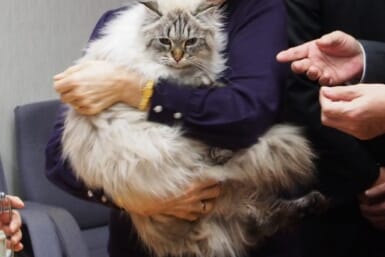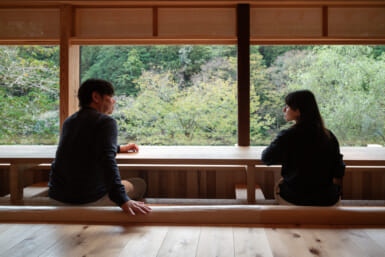“Glancing over the top of the seat in a railroad coach,” observed the American visitor to Japan, “one sees row upon row of black bristles and dark tresses.” Although it sounds as if it had been written during the days when Our Hosts lived in paper houses and geisha stood four abreast on every street corner, that passage, from William Forbis’s Japan Today, was written only 25 years ago.
Today, of course, millions of Japanese have forsaken their black bristles and dark tresses in favor of a veritable rainbow of colors. Of the twentysomething female office workers queried in a poll in the fall of ’99, fully 48 percent said they had changed their hair color—over a sevenfold increase since a similar survey was taken in 1992. Close to 40 percent of high school coeds (three times as many as in 1992) and over 10 percent of male salaried employees (five times as many) admitted to lightening their tresses. Chief among the reasons given by the respondents was “Black hair looks heavy,” followed by “I wanted to change the way I feel.”
Brown, blonde, red, pink, blue and green hair we can understand, but why gray? Because, as is so often the case with fads involving young people, someone else did it first. Specifically, some very cool someones, among them popular vocalist Namie Amuro, who dyed a portion of her already dyed-brown hair gray, and Koji Tamaki, a handsome actor-vocalist in his late 30s who stopped dyeing his prematurely gray hair for his appearance on a highly rated drama series.
Hair Magazine, a fashion monthly for teenaged males, reports that although readers in the 1980s most-often wrote in to request advice on how to deal with thinning or graying hair, readers today almost never seek help about the latter problem. According to research done by the Pola Center for the Study of Culture, nearly two-thirds of female high school students polled in 1991 favored getting rid of gray hair by dyeing it; in 1997, fewer than half of those queried advocated this procedure.
From 1992 to 1995, a time when the Japanese economy as a whole was in a very slow-growth mode, annual sales of cosmetics for men expanded from ¥195 billion to Y230 billion. And by “cosmetics for men,” we don’t mean shaving cream and hair tonic. In the 1970s, the male cosmetics firm, Mandom, was living up to the first syllable in its name by hiring tough-guy movie star Charles Bronson to slap on its after-shave lotion in televised commercials and growl, “Mmmmmmandom.” In March of 1997, the company premiered what has since become its top-selling product—specially treated paper for removing excess oil from otherwise lovely male faces.
If the desire for non-oily skin has transformed the fortunes of Mandom, the search for the hair stylist capable of dyeing your hair the perfect shade of chartreuse has had a similarly profound effect on Japan’s barber shops. From 1985 through 1995, around 2,500 of these businesses went kaput; the average age of the owners of this country’s remaining 142,000 tonsorial parlors is around 55. Like baby boomers suddenly waking up to the reality of middle age, many of these owners realize that their establishments have acquired an image as timeworn as straight razor strops and mustache cups.
Not unexpectedly, they’ve taken a cue from the nation’s beauty salons, which, before they began offering their patrons “aesthetic” treatments and body-sonic chairs, were places where middle-aged women passed the time under cone-shaped hairdryers by reading months-old gossip magazines. Among the trend-setting barber shops in Tokyo have been Salon de Kosson, where customers can have their hair dyed one or more of 36 colors, and Minato 3710, where a strand of your hair will be analyzed under a microscope to determine the best treatment for you. But perhaps the most useful service is offered by Hair Bar Ogiso.
The problem with most barbershops, including those where you can get your hair dyed one or more of 36 colors, is that you don’t know how you’ll look until it’s too late. Hair Bar Ogiso, however, came up with the idea of letting you check out a computer simulation of your proposed new ‘do to determine if it appears suitable atop your head.
And just like your home computer, you can eject anything that’s floppy.









